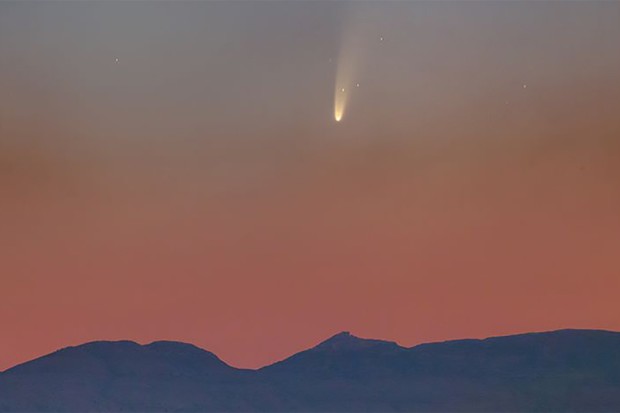Comet NEOWISE, which has amazed early morning risers the last couple of weeks, is now a beautiful sight in the evening sky, especially with binoculars.
There are dozens of comets gracing the night sky every year that are tracked by amateur astronomers. Most require a telescope and never rise to catch the attention of the general public. This comet, while not one of the rare, grand spectacles noticed even by the passerby who may not even have heard about it, is still a fine comet.
NEOWISE is bright enough to barely see with the unaided eye, depending on to what extent the sky is clear and dark, and how high it is. A simple pair of binoculars, like you may use to bird watch, will give you an astonishing view. You will want to keep on looking, night after night, to follow the comet’s progress.
This past week my wife and I keep looking for it, but stubborn clouds in the wrong spot just wouldn’t go away. Finally, on the third try, we saw it, Tuesday evening, July 14. You have to wait till about an hour after sunset – around 9:30 p.m. where I live, when the twilight has deepened enough. Find a place with a low, open view to the north-northwest. The bright head is the easiest to see, shining like a 1st-magnitude star, although fuzzy in appearance under magnification.
With eyes alone, I could trace the dimmer tail of comet dust, extending to the upper right for about 3 degrees. You can visualize the approximate length of 3 degrees by the width of two fingers held together when extending your arm straight out to the sky. The comet was about 10 degrees above the true horizon when I first saw it.
As the sky darkens and more stars come out, the comet appears brighter, although the downside is the comet is also getting closer to the horizon where the thicker air diminishes starlight and comet-light as well!
It was setting below the tree line at about 10:20 p.m. With binoculars, the comet is all the brighter, and you can see more detail. You may be able to detect how the dusty tail is split into two. A telescope may show the tail’s orange hue. The head of the comet, where the nucleus lies deep within the shroud of dust, appears yellowish.
Look for the Big Dipper, high in the northwest, to help you find the comet. On Saturday night, July 18, the comet is about 20 degrees below (about “three fists”) and slightly right of the front stars of the Dipper’s “bowl.”
The comet is gradually moving to the upper left, staying below the Big Dipper’s bowl through the coming week.
Climbing higher in the sky should improve your chances to catch NEOWISE, further up and away from the murky horizon, placed in a darker sky and perhaps finally clearing trees or other obstructions. It will, however, be slowly dimming. The farther north you live, the better the view will be.
The comet, which was discovered March 27, will be closest to the Earth on July 23.
Why is it named so funny? NEOWISE C/2020 F3 (its full designation) is named for the NASA infrared space telescope which discovered it on March 27. It rounded the sun on July 3, just inside the orbit of Mercury, and emerged in the early morning sky.
Try a smartphone picture if you use a tripod and can make a few-second exposure. A DSLR camera and telephoto lens will be much better. Please send me a picture if you get a good one! Make this a memory. For me, it was most enjoyable sharing it with my wife, and was enriched by the lightning bugs dancing about, seeing the bright planet Jupiter rising low in the east (and Saturn to the lower left) and, for an extra treat, the Space Station passing overhead.
This is also the 50th anniversary of when I bought my first telescope, a 3-inch Edmund reflector when I was 13. I used it to see Comet NEOWISE!
Up before dawn? Be sure to see brilliant Venus low in the northeast, just above the bright red star Aldebaran. New moon is on July 20. Look for the crescent moon through this week, in the western sky – well to the left of the comet!
Keep looking up at the sky!




























